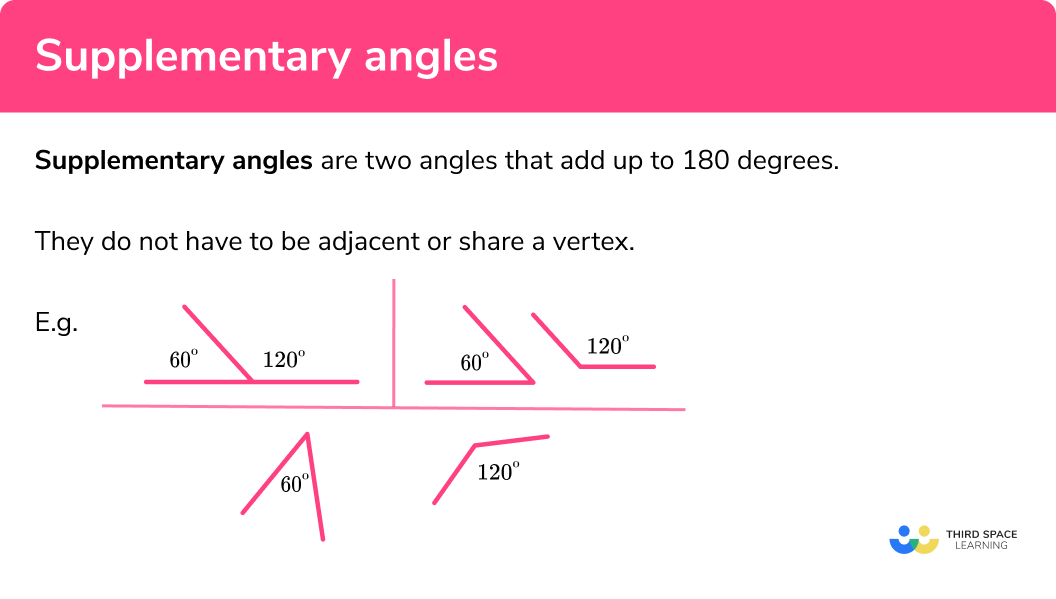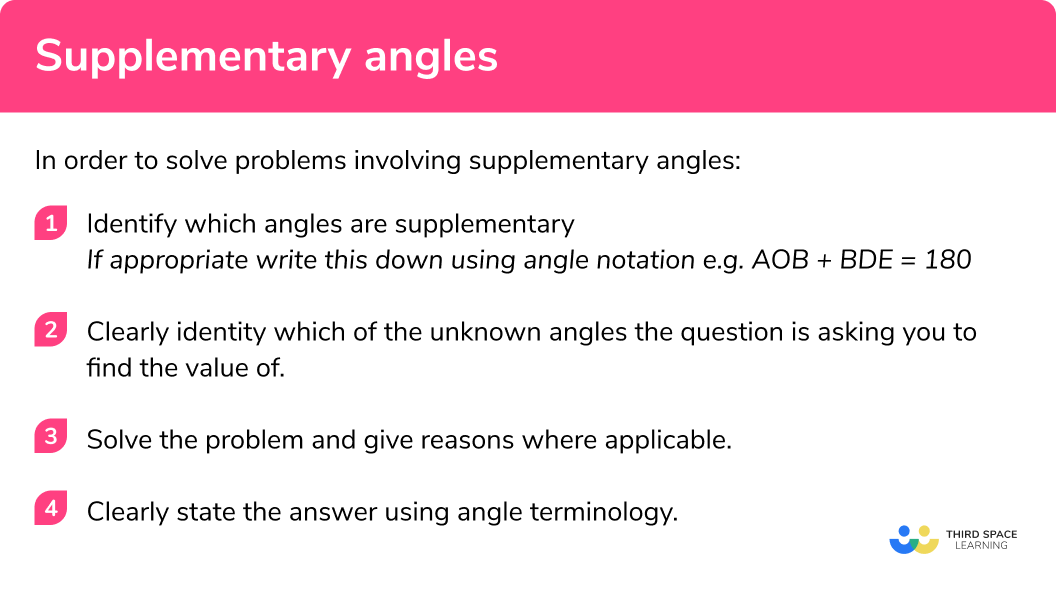One to one maths interventions built for KS4 success
Weekly online one to one GCSE maths revision lessons now available
In order to access this I need to be confident with:
Angle rules Types of angles Angles on a straight lineThis topic is relevant for:

Supplementary Angles
Here we will learn about supplementary angles including how to find missing angles by applying knowledge of supplementary angles to a context.
There are also angles worksheets based on Edexcel, AQA and OCR exam questions, along with further guidance on where to go next if you’re still stuck.
What are supplementary angles?
Supplementary angles are two angles that add up to
E.g.
When we add together supplementary angles we get a straight line. This is because a straight line is
Before we start looking at specific examples it is important we are familiar with some key words, terminology, rules and symbols required for this topic:
- Angle: defined as the amount of turn around a common vertex.
- Vertex: the point created by two line segments (plural is vertices).
- How to label an angle:
We normally label angles in two main ways:
1By giving the angle a ‘name’ which is normally a lowercase letter/symbol such as
2By referring to the angle as the three letters that define the angle. The middle letter refers to the vertex at which the angle is e.g. see the diagram for the angle we call
- Angles on a straight line equal 180°:
Angles on one part of a straight line always add up to
However see the next diagram for an example of where
- Angles around a point equal 360°:
Angles around a point will always equal
- Vertically opposite angles:
Vertically opposite angles refer to angles that are opposite one another at a specific vertex and are created by two lines crossing. See below for an example:
Here the two angles labelled
The same applies to angles labelled as
Note: Sometimes these are called vertical angles
What are supplementary angles?

How to solve problems involving supplementary angles
In order to solve problems involving supplementary angles:
- Identify which angles are supplementary.
If appropriate write this down using angle notation e.g. AOB + BDE =180 - Clearly identity which of the unknown angles the question is asking you to find the value of.
- Solve the problem and give reasons where applicable.
- Clearly state the answer using angle terminology.
How to solve problems involving supplementary angles.


Complementary and supplementary angles worksheet

Get your free complementary and supplementary angles worksheet of 20+ questions and answers. Includes reasoning and applied questions.
DOWNLOAD FREE
Complementary and supplementary angles worksheet

Get your free complementary and supplementary angles worksheet of 20+ questions and answers. Includes reasoning and applied questions.
DOWNLOAD FREESupplementary Angles examples
Example 1: finding an angle which is supplementary to another
Two angles,
- Identify which angles are supplementary.
The two angles are supplementary and therefore equal
2Clearly identity which of the unknown angles the question is asking you to find the value of.
Find the angle that is not
3Solve the problem and give reasons where applicable.
4Clearly state the answer using angle terminology.
The size of the other angle is
Example 2: finding an angle which is supplementary to another
Two angles are supplementary. One is double the size of the other. What is the size of the smaller angle?
Identify which angles are supplementary.
The two non-identified angles are supplementary and therefore equal
Clearly identity which of the unknown angles the question is asking you to find the value of.
You are being asked to find the smaller angle.
Solve the problem and give reasons where applicable.
If you call the first angle
The two angles are therefore of size
Clearly state the answer using angle terminology.
The smaller angle is
Example 3: finding supplementary angles from a diagram
Identify which angles are supplementary.
In this question you are not told which angles are supplementary.
Clearly identity which of the unknown angles the question is asking you to find the value of.
You are trying to find the angles that are supplementary. Therefore we are looking for two angles that when added together equal
Solve the problem and give reasons where applicable.
As angles that are supplementary equal
Clearly state the answer using angle terminology.
Angles
Example 4: finding a given angle using supplementary angles
Angles
Find the size of angle
Identify which angles are supplementary.
The two angles given as
Therefore
Clearly identity which of the unknown angles the question is asking you to find the value of.
Find the size of angle
Solve the problem and give reasons where applicable.
We can create an equation from the information given:
Remember you need to find the value of angle
Clearly state the answer using angle terminology.
Angle
Example 5: identifying supplementary angles
Identify which angles are supplementary.
In this question you are not told which angles are supplementary.
Clearly identity which of the unknown angles the question is asking you to find the value of.
You are trying to find the angles that are supplementary. Therefore you are looking for two angles that when added together equal
Solve the problem and give reasons where applicable.
Below is the diagram (given in the question) where the two sets of angles have been labelled separately. This will help you spot which are supplementary.
The angles are both obtuse angles therefore cannot add together to be
They are also congruent angles and known as corresponding angles because of their relationship within the two parallel lines.
The two angles here lie on a straight line and are therefore equal to 180° and are supplementary.
Clearly state the answer using angle terminology.
Example 6: identifying supplementary angles
Which angles in the below trapezium
Identify which angles are supplementary.
In this question you are not told which angles are supplementary.
Clearly identity which of the unknown angles the question is asking you to find the value of.
You are trying to find the angles that are supplementary. Therefore we are looking for two angles that when added together equal
Solve the problem and give reasons where applicable.
A trapezium has one set of parallel lines. From your prior knowledge of properties of a trapezium you know that, when added together, adjacent angles are equal to
They are also known as co-interior angles because of their relationship with the two parallel lines.
Clearly state the answer using angle terminology.
There are two sets of supplementary angles
- Angles
DAB andADC - Angles
ABC andBCD
Common misconceptions
These are some of the common misconceptions around the above angle rules
- Incorrectly labelling angles which are supplementary
- Assuming supplementary angles must share a vertex
- Mixing up supplementary angles and complementary angles
- Misuse of the ‘straight line’ rule where angles do not share a vertex
- Finding the incorrect angle due to misunderstanding the terminology
Related lessons
Supplementary angles is part of our series of lessons to support revision on angle rules. You may find it helpful to start with the main angle rules lesson for a summary of what to expect, or use the step by step guides below for further detail on individual topics. Other lessons in this series include:
Practice supplementary angles questions
1. Two angles ‘ x and y ‘ are supplementary and one of them is 47^{\circ} . What is the size of the other angle?




The two angles are supplementary, so they must have a sum of 180 and 47+133=180 .
2. Two angles ‘ x and y ‘ are supplementary and one of them is 123^{\circ} . What is the size of the other angle?




The two angles are supplementary, so they must have a sum of 180 and 57+123=180 .
3. Two angles are supplementary. One is three times the size of the other. What is the size of the smaller angle?




The angles make a 180 degree angle. There are three parts in one angle and one part in the other, so four parts in total. If we divide 180 by 4 we get 45 , so this is the size of the smaller angle.
4. Two angles are supplementary. One is 4x – 40 and the other is 5x – 50 . Find the value of x .




The sum of the two angles must equal 180 , so the equation we must solve is 9x-90=180 . Using the standard methods for solving a linear equation gives the solution x=30 .
5. Which angles are supplementary in the diagram below:
ACD and DBC

ABD and DBC

DAC and ACD

DAB and DBC

Since ABD and DBC meet at a point on a straight line, they must be supplementary as angles on a straight line add up to 180 .
6. How many pairs of supplementary angles does a parallelogram have?
0

1

2

4

By considering angle rules, we know there are four pairs of co-interior angles in a parallelogram. Since co-interior angles add up to 180 they are supplementary.
Supplementary angles GCSE questions
1. Find the size of the angle marked x .
(2 marks)
180 - 112
(1)
68^{\circ}
(1)
2.
(a) Which two pairs of angles are supplementary in this trapezium?
(b) Angle ADC=58^{\circ} . Find the angle BAD.
(3 marks)
a) BAD and ADC, ABC and BCD
(1)
b) 180 - 58
(1)
122^{\circ}
(1)
3. Work out the size of the smaller angle.
(4 marks)
7x - 4 + x + 16 = 180
(1)
8x + 12 = 180
(1)
\begin{aligned}
8x&=168\\
x&=21
\end{aligned}
(1)
21 + 16 = 37
(1)
Learning checklist
You have now learned how to:
- Use conventional terms and notation for angles
- Define angles that are supplementary
- Apply the properties of supplementary angles
- Apply angle facts and properties to solve problems
The next lessons are
Still stuck?
Prepare your KS4 students for maths GCSEs success with Third Space Learning. Weekly online one to one GCSE maths revision lessons delivered by expert maths tutors.

Find out more about our GCSE maths tuition programme.